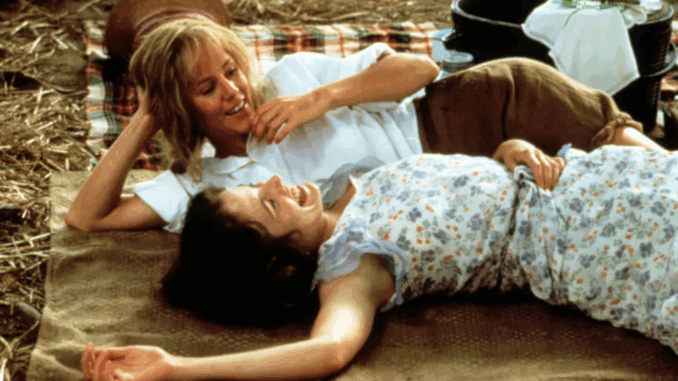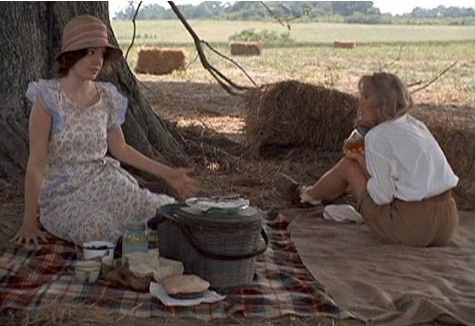
A Celebration of Wholeness
Among the many emotionally charged and bittersweet moments in Fried Green Tomatoes, one scene stands out for its fleeting joy and poignant stillness: a sunny picnic by the river. It may seem small at first glance—just a few characters laughing, eating, and relaxing—but in the broader context of the story, this picnic becomes a sanctuary in time, a fragile but perfect instance of peace before life unravels once more.
Ruth, Idgie, Sipsey, Big George, and young Buddy Jr. gather beneath the sprawling branches of sycamore trees on the banks of the river just outside Whistle Stop. The atmosphere is soft and slow, full of cicada buzz and birdsong. A red-and-white checkered blanket is spread over the grass, and baskets spill over with fried chicken, biscuits, lemonade, and of course, fried green tomatoes.
It’s a tableau of Southern warmth—but with subversive undercurrents. These characters, who have faced judgment, loss, and marginalization, are choosing joy. They’re building community on their own terms. It is a moment of intentional peace, not happenstance. And in its quietness, it becomes one of the most powerful emotional images in the film.
Found Family in Action
This picnic is more than a shared meal—it’s a reflection of the found family that has grown around the Whistle Stop Café. Ruth and Idgie aren’t just friends or coworkers. They are partners in every sense, and this moment shows their strength not through declarations, but through mutual presence. Ruth gently helps Buddy Jr. nibble a biscuit while Idgie tells him a wild story about her youth. Their dynamic radiates unspoken love and balance.

Sipsey and Big George, meanwhile, aren’t background figures—they are anchors. Big George flips corn cakes on a skillet and jokes with the children. Sipsey, ever watchful, makes sure everyone is fed and at ease. The café is closed for the day, but the energy remains communal. It’s the café without walls—open air, open hearts.
Together, they are a family of choice, not blood. In a time and place where racial segregation and gender conformity are enforced by law and custom, this group forms a bond of survival and trust. In the act of picnicking together—Black and white, queer and straight, young and old—they declare their unity without needing to say a word.
Foreshadowing Trouble
For all its sunlight and serenity, the scene is laced with unease. The camera lingers a little too long on Idgie’s face as she watches the treeline. Ruth flinches when Buddy Jr. wanders too far from the blanket. Sipsey briefly goes silent when she hears a dog bark in the distance. The tension is subtle but unmistakable.
That’s because Frank Bennett—Ruth’s abusive husband and the father of Buddy Jr.—still looms in the background. Though Ruth has escaped physically, the psychological scars remain. The group knows that men like Frank don’t always stay gone, and the world does not protect women who run. This moment of joy is, in many ways, their resistance against fear.
The contrast is deliberate. Joy, here, is revolutionary. Every moment of laughter is an act of defiance. And every bite of cornbread, every shared story, is a fragile victory over the violence of the outside world.
The Last Breath Before Change
What makes this picnic unforgettable is that it’s the last time we see all these characters together, unburdened and whole. Soon, the story will darken—Ruth will fall ill, Frank will return, and hard decisions will have to be made. The café will become a battleground for truth, loyalty, and survival. But none of that has happened yet.
This single afternoon, captured in golden light, becomes a preserved fragment of life before grief returns. And though the characters don’t know it, the audience senses it. The scene is soaked with foreshadowing, but also with grace. It is a reminder that even in lives full of trauma and loss, peace can—and must—be found, even if only for a day.
The river flows beside them, calm and steady. Buddy Jr. runs through the reeds with sticky hands and grass-stained knees. Idgie lies back and watches the clouds. Ruth’s eyes are full of something like contentment. Sipsey hums a tune only she knows. These are people who have been shaped by loss, who will be shaped by more to come—but for this moment, they are simply living.
Conclusion: A Scene of Radical Stillness
In a film filled with flashbacks, courtroom drama, and powerful declarations, this picnic scene might seem small. But in its simplicity, it becomes one of the film’s most radical moments. It shows that stillness can be powerful, that peace can be active, and that community can be quietly revolutionary.
It’s not about what is said—it’s about what is felt. The touch of a hand, the passing of a plate, the way Ruth and Idgie share a look that says everything and nothing all at once. This is storytelling at its most intimate.
Fried Green Tomatoes reminds us through this moment that sometimes, the most meaningful scenes are not those of conflict or climax, but of connection. This picnic by the river is more than a breath between storms—it is a memory of what life is fighting for.
